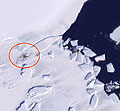Poring over satellite photographs, researchers from the British Antarctic Survey (BAS) have discovered 10 new emperor penguin colonies in Antarctica by spotting telltale brown excrement patches on snow and ice. Emperor penguins — the world’s largest penguin, reaching four feet tall and weighing more than 80 pounds — spend eight months breeding and rearing chicks on sea ice around Antarctica, creating large fields of guano. Studying satellite photographs taken from 1999 to 2004, BAS researchers discovered 10 previously unknown emperor penguin colonies and learned that four previously known colonies had disappeared. Based on this research, published in the journal Global Ecology and Biogeography, the researchers concluded that 38 emperor penguin colonies now exist in Antarctica, harboring a population of 200,000 to 400,000 breeding pairs. The life cycle of emperor penguins is heavily dependent on sea ice, and numerous researchers have predicted recently that as Antarctica warms and sea ice melts, emperor populations will decline sharply.
Emperor Penguin Colonies Discovered by Spotting Guano from Space
More From E360
-
Solutions
From Ruins to Reuse: How Ukrainians Are Repurposing War Waste
-
ANALYSIS
Carbon Offsets Are Failing. Can a New Plan Save the Rainforests?
-
Energy
Facing a Hostile Administration, U.S. Offshore Wind Is in Retreat
-
Biodiversity
As Jaguars Recover, Will the Border Wall Block Their U.S. Return?
-
WATER
An E.U. Plan to Slash Micropollutants in Wastewater Is Under Attack
-
INTERVIEW
This Data Scientist Sees Progress in the Climate Change Fight
-
Climate
As Floods Worsen, Pakistan Is the Epicenter of Climate Change
-
Climate
Heat Stress Is a Major Driver of India’s Kidney Disease Epidemic
-
Energy
It’s a ‘Golden Age’ for U.S. LNG Industry, But Climate Risks Loom
-
Climate
How Climate Risks Are Putting Home Insurance Out of Reach
-
INTERVIEW
Inside the Plastics Industry Playbook: Delay, Deny, and Distract
-
Biodiversity
Freeing Captive Bears from Armenia’s Backyards and Basements
